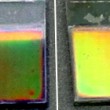Home > Press > Electrochromic Bragg mirror
 |
Abstract:
Researchers report the first example of an electrochromic Bragg mirror based on nanoporous multilayers of nickel oxide and tungsten trioxide nanoparticles.
Electrochromic Bragg mirror
Germany | Posted on September 13th, 2012Electrochromic materials change their color by electrically induced storage of ions and electrons in the material. This storage can be reversed by applying an opposing electrical bias.
Two prototypical electrochromic materials are tungsten trioxide, W(VI)O3, and nickel oxide, Ni(II)O.
Now, for the first time, both materials have been combined in a single photonic crystal architecture, where tungsten trioxide is the high refractive index component and nickel oxide the low refractive index component.
In contrast to electrochromic photonic crystals based on a single material, an applied potential does not lead to a strong spectral shift of the photonic stop band. Instead, the device behaves as an electrochromic Bragg mirror, where the reflectance can be modulated by the applied potential.
This reflectance modulation may be useful for tunable mirror devices and for grayscale control in reflective displays, such as ebooks.
The research was reported in Advanced Optical Materials, a new section in Advanced Materials dedicated to breakthrough discoveries and fundamental research in photonics, plasmonics, metamaterials, and more, covering all aspects of light-matter interactions.
####
For more information, please click here
Copyright © Wiley-VCH Materials Science Journals
If you have a comment, please Contact us.Issuers of news releases, not 7th Wave, Inc. or Nanotechnology Now, are solely responsible for the accuracy of the content.
| Related Links |
![]() To get Advanced Optical Materials email alerts: click here:
To get Advanced Optical Materials email alerts: click here:
![]() The paper, “Electrochromic Bragg Mirror: ECBM”, is free to download for a limited time:
The paper, “Electrochromic Bragg Mirror: ECBM”, is free to download for a limited time:
| Related News Press |
News and information
![]() Researchers develop molecular qubits that communicate at telecom frequencies October 3rd, 2025
Researchers develop molecular qubits that communicate at telecom frequencies October 3rd, 2025
![]() Next-generation quantum communication October 3rd, 2025
Next-generation quantum communication October 3rd, 2025
![]() "Nanoreactor" cage uses visible light for catalytic and ultra-selective cross-cycloadditions October 3rd, 2025
"Nanoreactor" cage uses visible light for catalytic and ultra-selective cross-cycloadditions October 3rd, 2025
Discoveries
![]() Researchers develop molecular qubits that communicate at telecom frequencies October 3rd, 2025
Researchers develop molecular qubits that communicate at telecom frequencies October 3rd, 2025
![]() Next-generation quantum communication October 3rd, 2025
Next-generation quantum communication October 3rd, 2025
![]() "Nanoreactor" cage uses visible light for catalytic and ultra-selective cross-cycloadditions October 3rd, 2025
"Nanoreactor" cage uses visible light for catalytic and ultra-selective cross-cycloadditions October 3rd, 2025
Announcements
![]() Rice membrane extracts lithium from brines with greater speed, less waste October 3rd, 2025
Rice membrane extracts lithium from brines with greater speed, less waste October 3rd, 2025
![]() Researchers develop molecular qubits that communicate at telecom frequencies October 3rd, 2025
Researchers develop molecular qubits that communicate at telecom frequencies October 3rd, 2025
![]() Next-generation quantum communication October 3rd, 2025
Next-generation quantum communication October 3rd, 2025
![]() "Nanoreactor" cage uses visible light for catalytic and ultra-selective cross-cycloadditions October 3rd, 2025
"Nanoreactor" cage uses visible light for catalytic and ultra-selective cross-cycloadditions October 3rd, 2025
Photonics/Optics/Lasers
![]() ICFO researchers overcome long-standing bottleneck in single photon detection with twisted 2D materials August 8th, 2025
ICFO researchers overcome long-standing bottleneck in single photon detection with twisted 2D materials August 8th, 2025
![]() Institute for Nanoscience hosts annual proposal planning meeting May 16th, 2025
Institute for Nanoscience hosts annual proposal planning meeting May 16th, 2025
|
|
||
|
|
||
| The latest news from around the world, FREE | ||
|
|
||
|
|
||
| Premium Products | ||
|
|
||
|
Only the news you want to read!
Learn More |
||
|
|
||
|
Full-service, expert consulting
Learn More |
||
|
|
||








